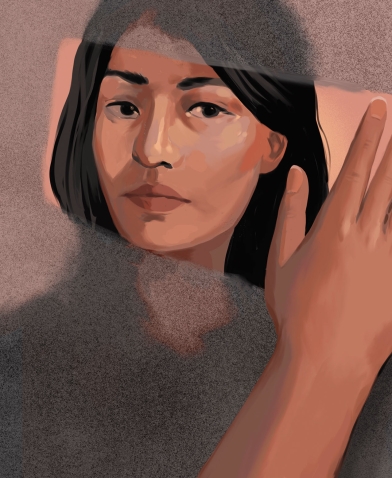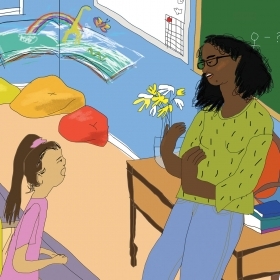A memory from the start of the COVID-19 pandemic remains indelible. It was early March 2020, and schools and businesses were yet to close down. But already a gnawing sense of foreboding loomed, apart from the virus itself.
My fears were confirmed by a LinkedIn post from an Asian American friend. He was in Central Square in Cambridge, Mass., when a man menaced him on the street, blamed him for the virus, and continued threatening him even when police arrived on the scene.
I was already worried about the potential impact on Asians in the U.S. who might be irrationally targeted because the virus had originated in China. Thousands of innocent people in China itself would be sickened by COVID-19 or die, but those tragic facts could be overshadowed by ignorance, anger, fear, and knee-jerk racism.
I was especially concerned because my mother, an immigrant in her 70s born in Hong Kong, takes the T to work in Boston’s Chinatown every day. She has continued to do so throughout the pandemic.
After I read the LinkedIn post from my friend, I asked my mother if anything had happened to her. As she snapped green beans for dinner, she quietly said yes. Twice already, people had harassed or threatened her on the street near Chinatown and in a store near home. “I hope I’m not being too sensitive,” she said without pausing her bean snapping.
My mother’s response was typical of many older Asian American immigrants accustomed to hardship and indignities—too accustomed, from my American-born perspective. But I was alarmed and upset. I immediately emailed authorities in Boston in hopes of preventing future incidents.
Older Asian Americans often don’t discuss negative events, even with family members, partly because they don’t want to worry anyone. A year later, in spring 2021, after racism and violence against Asian Americans surged across the country, my brother gave my parents perverse “gifts” of hand-held panic alarms. When I mentioned that our mother had been harassed, it was the first my brother had heard of the incidents. We quizzed my mother on whether anything else had happened since. She unconvincingly said no and busied herself at the kitchen sink to avoid our inquiries.
As if a deadly virus weren’t enough to deal with, Asians in the U.S. and in other countries where they are racial minorities also face the risk of harassment and violence. Last year, when I warned friends and classmates to be aware, many of them seemed surprised. It was another confirmation of the harmful misconception that Asian Americans do not experience discrimination, social inequities, or injustice.
A Spike in Violence
Unfortunately, my fears were borne out. In spring 2020, a man stabbed a Burmese American father who was shopping with his two young children at a Sam’s Club in Texas. An attacker threw acid on an Asian woman in Brooklyn, N.Y., in front of her home. Early on, the FBI predicted that anti-Asian hate incidents would increase. I attended an online event where officials from the FBI, Department of Justice, New York Police Department, and New York’s attorney general’s office spotlighted the spike in anti-Asian hate.
But by early May 2020, media attention had faded. I pitched an op-ed to a newspaper editor, and she replied: “I think we won’t want to delve into this subject again very soon.”
Meanwhile, attacks on Asians continued. Anti-Asian hate crimes in 16 major U.S. cities spiked 164% in the first quarter of 2021 compared with the previous year. The nonprofit Stop AAPI Hate tallied more than 9,000 incidents of anti-Asian harassment and violence from March 2020 through June 2021. And it’s likely that hate incidents are still vastly underreported.
Michelle Lee ’12, a resident physician in New York City, was in midtown Manhattan last year when a man spat on her as he glared at her. She didn’t report the incident, although she thinks it was “100% racially targeted. I was the only Asian person there,” she recalls. A few months later, another man spat on her in New York. This year, another sexually harassed her on the subway in a frightening encounter.
Lee was born in Flushing, Queens, home to a large Asian population, and attended high school in Long Island. As a New Yorker, she was aware of racial slurs and tensions. But hostility during the pandemic has been much worse than anything she experienced before. “I never felt anti-Asian hate sentiment so palpably. I was never afraid to get on the subway at night,” says Lee.
Unfortunately, Lee’s experiences are not unique. They are part of a string of attacks on Asian Americans and fellow health workers. A nurse of Asian descent at Mount Sinai Hospital in Manhattan was punched in the stomach as she left work, Lee told me. The nurse didn’t report the attack. A friend’s grandmother was assaulted outside church and hospitalized in Flushing. Oranicha “Natty” Jumreornvong, a Mount Sinai medical student from Thailand, was kicked, dragged, and robbed as she headed to her shift in February 2021. Passersby stood in silence until Jumreornvong, bleeding and injured, asked someone to call 911.

An Unequal Pandemic
While all this was happening, I noticed something distressing in the many online panels I watched about the economic and health impacts of COVID-19. Economists, public health officials, academics, and journalists all emphasized the virus’s outsized impact on racial minorities. But in these discussions, Asian Americans were never mentioned.
They were notably absent in spite of the devastating impact on working-class Asians who disproportionately work in industries affected by the lockdown: restaurants, nail salons, dry cleaners, laundries, hospitality, construction, and domestic work.
By July 2020, 83% of Asian Americans in California with a high school education or less had filed unemployment claims, compared with 37% for the general California labor force with the same level of education, according to a UCLA analysis. And in New York state, unemployment claims among Asians jumped more than 6,500% by summer 2020, according to the Asian American Federation. Chinatowns and neighborhoods with large Asian communities such as Flushing, Queens, were hit earlier and harder by the economic slowdown, according to Mastercard.
Yet many people seemed unaware that countless Asian Americans were suffering during the pandemic. Especially vulnerable were the low-income, those with limited English, the elderly, and the 1.7 million undocumented Asians in the U.S.
Asian Americans and Pacific Islanders (AAPIs) were also hard hit by the virus itself. In an analysis of COVID-19 patients in New York City’s largest public hospital system in spring 2020, Chinese people had the highest death rates. A large national study from the Kaiser Family Foundation showed that Asian COVID-19 patients were the most likely to die among all races and had the lowest rates of testing. In California, Native Hawaiians and Pacific Islanders had the highest COVID-19 death rates. Yet AAPIs were left out of discussions about the virus’s impact on minorities.
This erasure was especially harmful because vulnerable Asian Americans are among those who are most threatened by hate incidents. They can’t work from home in their working-class jobs. They take public transportation, not Uber. And they tend not to report incidents due to language and cultural barriers, as well as fear of jeopardizing their immigration status if they are not U.S. citizens.
As a journalist for more than 20 years, I had never written about Asian Americans, despite personal interest. That was partly because I thought editors were less interested in stories about Asian Americans and the challenges they face.
But last year, when I realized how Asian Americans were neglected by “experts” and the media during a multi-faceted crisis of health, economic hardship, and racism, I began writing articles focusing on social disparities among AAPIs. I knew it would be harder to convince editors that these were newsworthy stories. The model minority myth that Asians are “doing well” particularly diminishes the urgent needs of neglected Asians. But that changed on March 16, 2021, when a man shot and killed eight people, including six Asian women, in spas near Atlanta.
A Turning Point
The heinous mass shooting humanized vulnerable, working-class Asians. Three of the Asian victims were women in their 60s and 70s. They reportedly had been relieved to be working again after lockdown restrictions were lifted this spring. Another victim, Feng Daoyou, was an undocumented recent immigrant from China. The Atlanta shootings opened the floodgates for stories about violence against Asians that goes unnoticed, even though people were being attacked in broad daylight during the pandemic.
By spring 2021, as most people were celebrating getting vaccinated and going out to enjoy life again, Asian Americans friends were telling parents and older relatives not to leave home. My friend Sonya Rhee ’98 ordered alarms, a stun cane, and a tactical flashlight for her 71-year-old mother. Images of Asian seniors in Los Angeles, Boston, and New York learning to defend themselves with their canes was another perverse sign of the times.
Yet the Atlanta shootings also served as a galvanizing wake-up call. In March 2021, Michelle Lee organized about 100 health-care workers in a rally against anti-Asian hate in Manhattan’s Chinatown. She and fellow medical school students had previously rallied in a White Coats for Blacks Lives group. Now it was time to stand up for themselves and other Asians.
“The Atlanta shootings hit me personally,” says Lee. “They were just small-business workers. That’s the community that I come from.” As a first-generation college graduate, she understands the language and cultural barriers that immigrants face. “It wouldn’t be right if I didn’t speak up for my community,” she says.
The rise in anti-Asian racism also changed Lee’s perspective on the traditional approach of working hard and keeping one’s head down. “As terrible as it was, for many Asian Americans, it was a turning point for this new generation to use their voice and advocate for their community,” she says. “I’m realizing it doesn’t stop there. Actually, the Asian American dream is to give back to the Asian American community and give back to our parents and grandparents who got us here in the first place.”









We ask that those who engage in Wellesley magazine's online community act with honesty, integrity, and respect. (Remember the honor code, alums?) We reserve the right to remove comments by impersonators or comments that are not civil and relevant to the subject at hand. By posting here, you are permitting Wellesley magazine to edit and republish your comment in all media. Please remember that all posts are public.